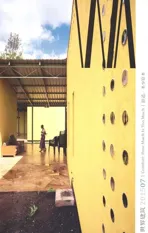Base Camp儿童宿营地,斯塔万格,挪威
2015-12-22建筑设计西夫斯唐厄兰赖因哈德克罗普夫穆威挪威HHA建筑事务所
建筑设计:西夫·斯唐厄兰,赖因哈德·克罗普夫,穆威/挪威HHA建筑事务所
Base Camp儿童宿营地,斯塔万格,挪威
Base Camp, Stavanger, Norway, 2009
建筑设计:西夫·斯唐厄兰,赖因哈德·克罗普夫,穆威/挪威HHA建筑事务所

1 树屋外景/Exterior view, the Tree Camp

2 树屋总平面/Site plan, the Tree Camp
该项目业主——挪威西海岸城市斯塔万格旅游局希望在城市北部的高山湖山地,毗邻著名的祈祷峰景区打造一片让儿童接近自然、感受自然的宿营地。挪威人有着与生俱来的和自然亲近的生活习惯,自维京时代伊始,挪威的文化便与自然为伴,即便在今天,挪威的很多幼儿园依然保留着在寒冷的室外进行午休这一教育传统。基于这样的背景,舒适,与精美无关,与温度无缘,传统建筑设计追求的表演性更无从谈起。相反,舒适指向了房子和自然环境的某种关系设定,舒适度来自儿童行为在自然环境和人造物之间转换的某种独特体验。作为儿童宿营地,这是挪威式的舒适度诉求,它不是将都市中的儿童房放置于自然之中,它是自然界中微弱的遮蔽物,让儿童获得淋漓尽致的自然体验。
我们因此将设计的命题设定为:人造物与自然是否可以融为一体,使之成为自然体验的放大器。建筑物不再是绝对意义上的人造物,而是展示出顺应自然、甚至向自然学习的姿态。于是,我们设计了一组建筑,尝试和场地内的自然要素发生一一对应的建筑行为学关系:
1 树屋
树屋是6个如蚕茧般的房子,悬挂在树林间,其中的4个由悬桥串联在一起,儿童可以在树间漫步,也可以在树屋里休憩。
2 悬崖上的房子
选址位于悬崖上岩石自然坍塌后留下的凹口,用建筑物将其填充,独特的结构限定出若干悬挂的休憩空间,攀岩是抵达建筑的唯一途径,建筑物促成了攀岩行为和山体的精确关系。
3 水边的房子
选址位于高山湖对面的无人区,木结构是岩石形体的延伸,终止于水边的木屋,游泳高手和皮划艇爱好者才能抵达这里,享受这里的露台和茶室。
在建筑存在之前,“物”已经存在。我们赞美物质,一定程度上建筑师做的不是去所谓地创造事物,而是去打磨、挖掘、重组织和再现一个可以承载生活的容器。这是一组弱建筑,更不奢望有永恒感和纪念性,它是一次行为物质化的实验。□(穆威)
项目信息/Credits and Data
业主/Client: 斯塔万格旅游局/Stavanger Turistforening设计时间/Design Period: 2008-2009
摄影/Photos: Emile Ashley, Helen & Hard

3 树屋内景/Interior view, the Tree Camp

4.5 树屋外景/Exterior view, the Tree Camp

6 树屋立面/Elevation, the Tree Camp

7 树屋剖面/Section, the Tree Camp

8 悬崖上的房子外景/Exterior view, the Mountain Camp

9 悬崖上的房子剖面/Section, the Mountain Camp
Stavanger Trekking Association wished to create a camp site for children to approach and experience nature.
This has resulted in three different "base camps", each accommodating 12-15 children on camping-tours in the surroundings of the Prekestolen mountain lodge. The design process started with extensive hiking tours to find suitable spots and a unique spatial concept for each structure. Ideas for each cabin were not predefined but rather emerged from encounters with the various natural surroundings. This process resulted in three base camps which opened in the spring of 2009: The Mountain Camp, The Water Camp and the Tree Camp. The natural setting supplements the structure of each camp; all camps are light constructions that have only slight impact on their surroundings and can be easily disassembled.
The Norwegian people have an inherent affinity to nature, of which cold is a crucial part. Therefore in this tradition, comfort has little to do with exquisite details, warmth, or generic performance of a building. On the contrary, it signifies certain relationship between the buildingand its environment. Comfort is generated through a unique experience of transition from the civilized world to the natural one. As a camping site, it represents the Norwegian pursuit for comfort, and is meant to function as a basic shelter, a tool or a tunnel for children to approach and enjoy nature.
In the Mountain Camp children sleep inside a steel construction attached to a steep rock. The entire camp is hung on steel-wires; pressure-loaded steel tubes create a distance between the rock and the steel-wired facade. These also double up as the construction for the beds, which are arranged over five levels fixed between the steel tubes. Children have to climb up the rock along a zigzag route to reach their camp. The cabins are covered with cotton which has been camouflage painted to match the cracks of the rock behind the facade. This pattern determines the placement of the panorama-window for each cabin.
The Tree Camp consists of six small cocoonlike rooms hung around living trees, which provide shelter for the children. Four of them are connected with a hanging bridge, which leads into the larger room on one end where all the children can meet and prepare food. Each cabin has three beds plus storage for rucksacks underneath.
The Water Camp is located on an uninhabited site opposite the mountain lake. It has hammocks on a covered quay and a textile curtain that can be rolled down to keep out the rain. The camp is built into the rock and its roofs follow the dramatic rock formation. This camp is designed for skilled swimmers and kayakers to enjoy its patio and tearoom.
Base Camp favors interactive nomadic structures and intends to help trigger interests in play and learning.The camps derive their material structures from dialogue with the natural environment and form a playful praxis.
Before architecture, "matter" exists. Matter matters, and in a sense the architects' job is not creating something new, but polishing, reorganizing or representing the physical components as a envelop or container of social behaviors. This is a series of weak buildings; instead of eternity and monumentality, it is meant to be an experiment on the architectural materialization of behaviors. □ (Text by MU Wei)

10 悬崖上的房子外景/Exterior view, the Mountain Camp

11.12 悬崖上的房子内景/Interior view, the Mountain Camp

13 水边的房子外景/Exterior view, the Water Camp
评论
丁力扬:有关追求建筑空间舒适度和相关建造资源消耗的平衡问题,本质上是针对人、建筑和自然之间三者关系的讨论。挪威斯塔万格儿童宿营地的几个小建筑设计探索的是一种有别于常规意义下人工环境试图压倒(取代)自然环境的舒适度。也就是说,建筑师在极为克制的前提下,以营造最低标准的人工环境为目标——尽管无法达到相对舒适的人工环境,但这种处理方式却可以创造条件,让使用者能够在满足最基本停留可能的“室内空间”中,最大限度地体验其所处自然环境给予的真实感受。在这3个小尺度建筑中,建筑师都邀请了自然元素参与空间围合的工作,这些自然元素也随之成为了建筑的一部分。而3种自然元素参与建造的程度,都以作为组成部分的自然元素在脱离建筑整体之后,建筑还能否成立为判断标准。显然,如果没有了悬崖上的岩石、笔直的树干和水岸边的巨石,这些建筑都无法作为独立的整体存在,也无法营造最基本的室内环境为孩子们体验自然提供最起码的条件。姜涌:山居、树居、水居,与自然亲密接触中的诗意栖居,恐怕是所有建筑的理想和建筑师的梦想。儿童宿营地的建筑命题让这种尝试成为了可能,设计者用环境友好、敬畏自然的态度建造了最小舒适度、最简约质朴的建筑。这其实告诉我们一个真理:如果承认大自然是最伟大的造化师,而我们人类只是匆匆而喧闹的过客,那么所有的建筑欲望都应当是这样节制而收敛的。
Comments
DING Liyang: The issue regarding the balance between spatial comfort and corresponding consumption of construction recourses is essentially a discourse on the relationship between man, architecture and nature.This series of projects seek to create a kind of comfort that is different from conventional approaches in which the artificial environment overwhelms or even substitutes the natural environment. Specifically, it is
an approach that strives to create a certain artificial environment with minimum standards and maximum authenticity. In each of the three small buildings, the architect introduced different natural elements as spatial enclosure devices, eventually making these elements integral parts of the buildings. To what extent these natural elements are involved in the respective construction of the three buildings depends on whether or not they would still be held together once those natural elements are removed. Apparently, deprived of upright tree trunks, cliffs and waterside rocks, none of the three buildings would exist as independent, complete structures, nor could they even provide the most basic settings for the children to experience nature.
JIANG Yong: It is perhaps an ideal of all buildings and a dream of all architects to live poetically through intimate contact with nature, in the company of trees, mountains and rivers. The architectural theme of the children's camp has made such attempt possible. With environment-friendly and nature-venerating attitudes, the designer has created a building of maximum simplicity and minimum comfort, which actually reveals a truth: if we deem Mother Nature as the greatest creator, whereas we humans are just bustling passers-by, then all desires for architecture should be restrained like this.

14 水边的房子总平面/Site plan, the Water Camp

15.16 水边的房子外景/Exterior view, the Water Camp
